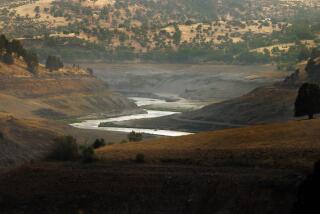L.A. County crews to begin removing mud from basin behind Pasadena dam
- Share via
The Los Angeles County Department of Public Works will start work in July to remove 25,000 cubic yards of sediment from the basin behind Devil’s Gate Dam in Pasadena.
The project is a stopgap measure to prevent valves and other dam works from becoming clogged this winter while the county studies options for the eventual removal of roughly 1.5 million cubic yards of mud and debris, most of it deposited after the August 2009 Station fire.
Excavation work, which could begin as early as July 5, would be limited to within about 100 feet of the face of the dam — leaving all wooded areas in the basin intact and eliminating the need for dirt-hauling trucks to pass through La Cañada Flintridge, said Chris Stone, assistant deputy director of the public works department’s Water Resources Division.
“We need to remove sediment that’s accumulated around intake structures to make sure they remain operational over the next one or two winters while we pursue [a study] for the larger project,” Stone said. “If we couldn’t operate the valves, we could no longer discharge water downstream, and then it could build up and go over the stow way.”
Dirt removed from behind the dam this summer will either be stored temporarily at Johnson Field, an unused Pasadena groundwater restoration basin nearby, or hauled out past the southern end of the JPL parking lot, down Windsor Avenue in Altadena and east along the 210 Freeway to a fill area in Irwindale.
Pasadena City Council members are expected to decide June 20 whether to allow use of Johnson Field, an option that would not interfere with maintenance of Hahamongna Watershed Park, said Dan Rix, a Pasadena city engineer.
Updated on the project last week, La Cañada Flintridge City Council members expressed concern that one of several potential truck routes under study for future work involves using Oak Grove Drive to access the freeway.
“In my eyes, you guys are some of the heroes of our debris flow problem, only my biggest concern is the haul route when you start cleaning it out,” said Councilwoman Laura Olhasso, who called for the city to hold a future project scoping meeting.
The eventual removal of millions of cubic yards of sediment would require 300 to 400 truck trips per day out of the basin over several months, Stone said.
The larger project would also involve the destruction of about 50 acres of woodland that’s grown on years of mud deposits behind the dam, creating a habitat for wildlife and a popular spot for local hikers, dog walkers and equestrians.
“This is an escape from the congestion of the city. We should slow down and think about this,” said downtown Los Angeles resident James Emrich, who visited the basin recently.
Public works officials initially sought to begin removing all 1.5 million cubic yards this summer, but the plan was halted in March when the Los Angeles County Board of Supervisors, acting on a motion from Supervisor Michael D. Antonovich, ordered an environmental impact study. The move is expected to delay the larger sediment removal project for as much as two years.
“Not only were there impacts to the environment, the project was going to have a significant impact on the community,” said Edel Vizcarra, planning deputy for Antonovich.
Vizcarra praised the partial summer cleanout for temporarily preserving recreational space while restricting truck traffic.
Stone said that work in July would occur from 7:30 a.m. to 4 p.m. on weekdays for three to four weeks, leaving adjacent areas open to the public on weekends.
After the sediment is removed, county officials will make improvements to the dam aimed at preventing potential debris blockages.
Rainstorms in the months after the 2009 Station fire in the Angeles National Forest deposited about 1 million cubic yards of mud and debris behind Devil’s Gate Dam, built in 1920.
An additional 300,000 to 500,000 cubic yards flowed into the basin last winter, Stone said.
“In the first storm season after the fire, the sediment level went up 25 feet,” he said. “That’s a million cubic yards in one season. Without a burned watershed, we only got 100,000 cubic yards in 10 years.”
More to Read
Sign up for Essential California
The most important California stories and recommendations in your inbox every morning.
You may occasionally receive promotional content from the Los Angeles Times.










